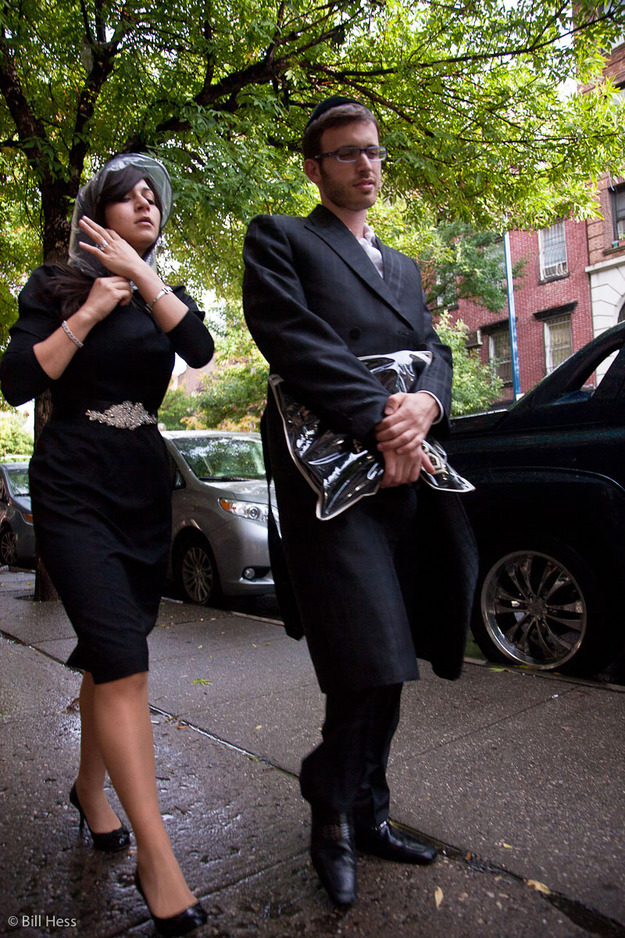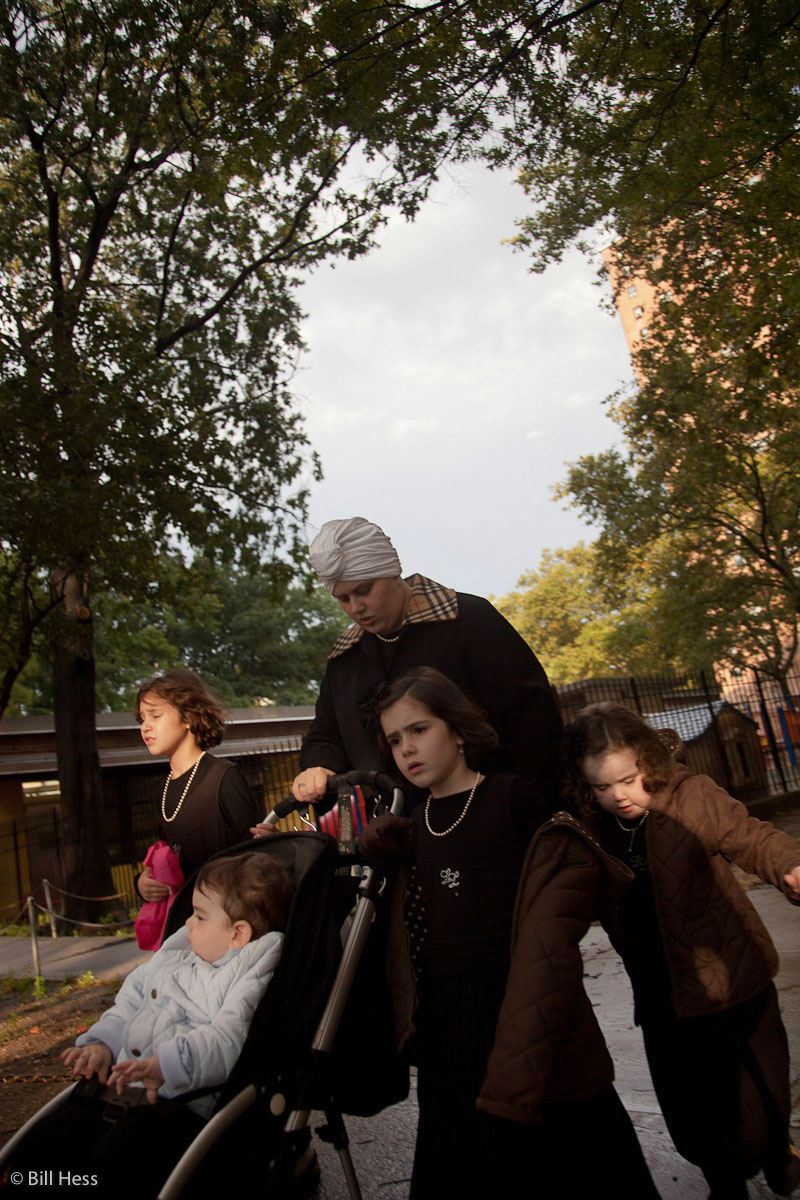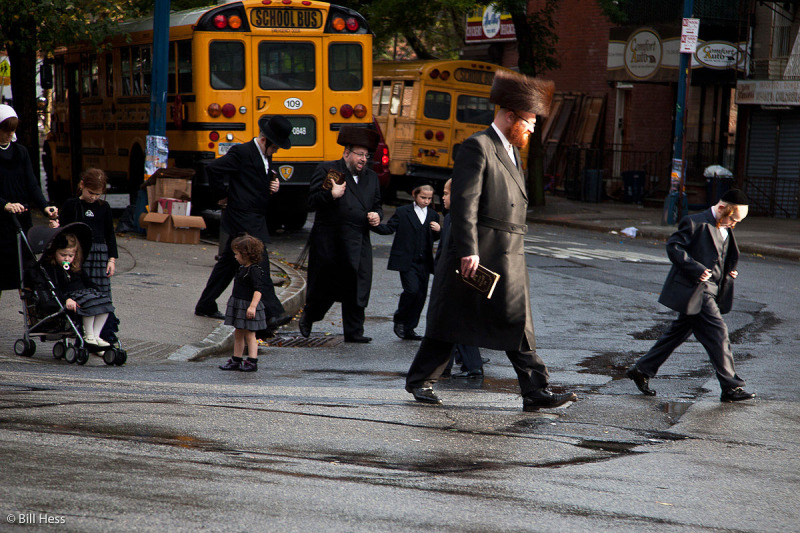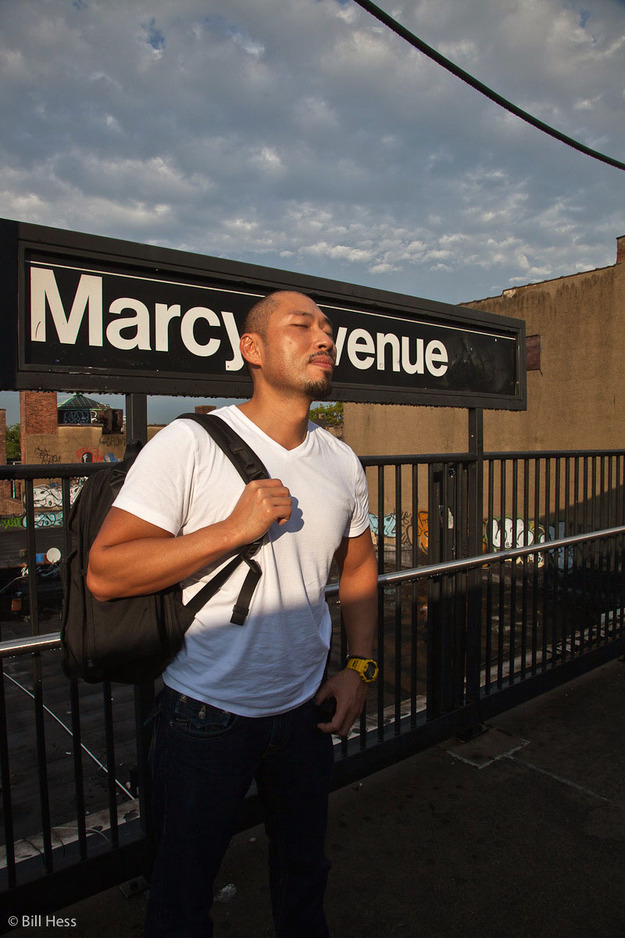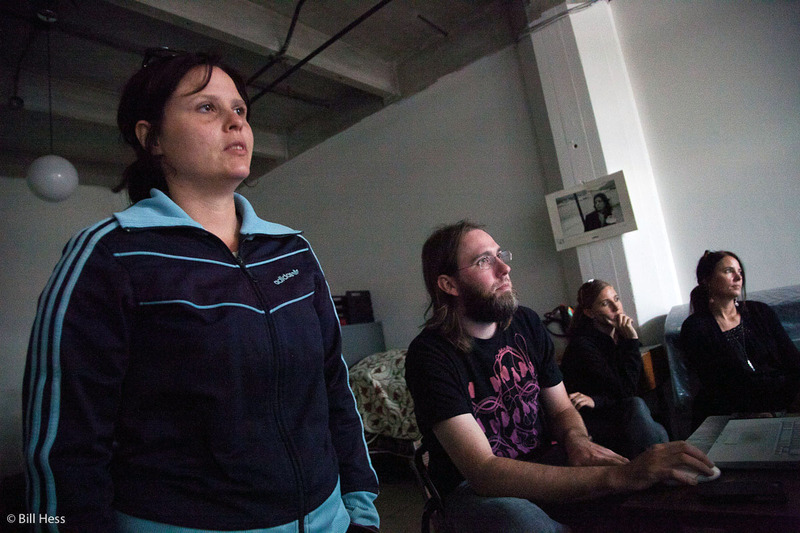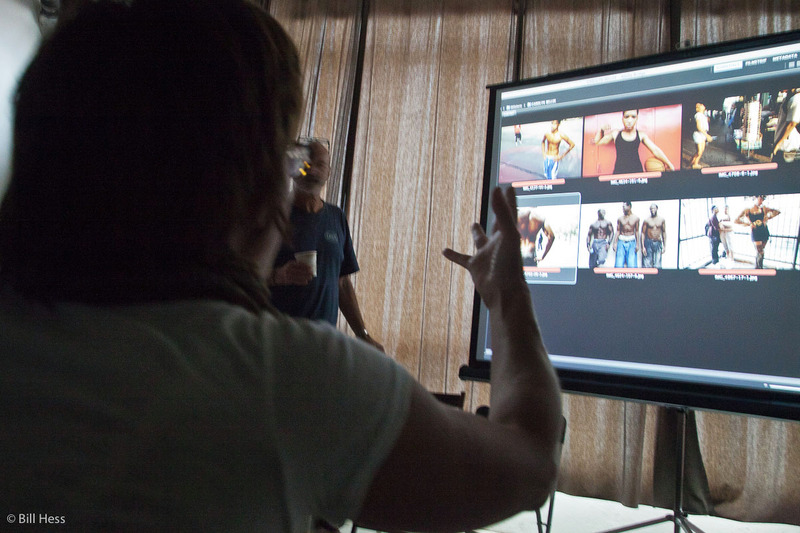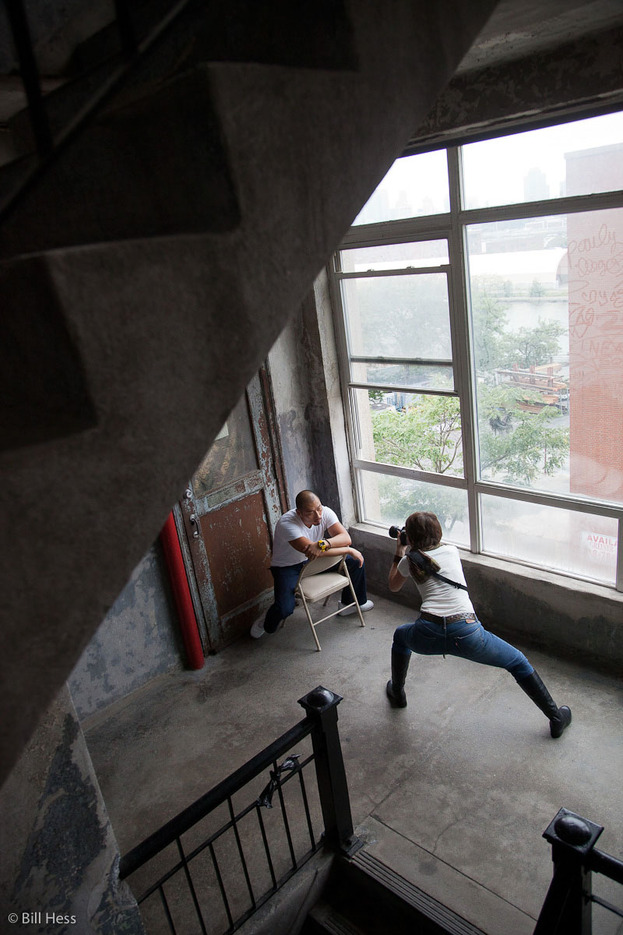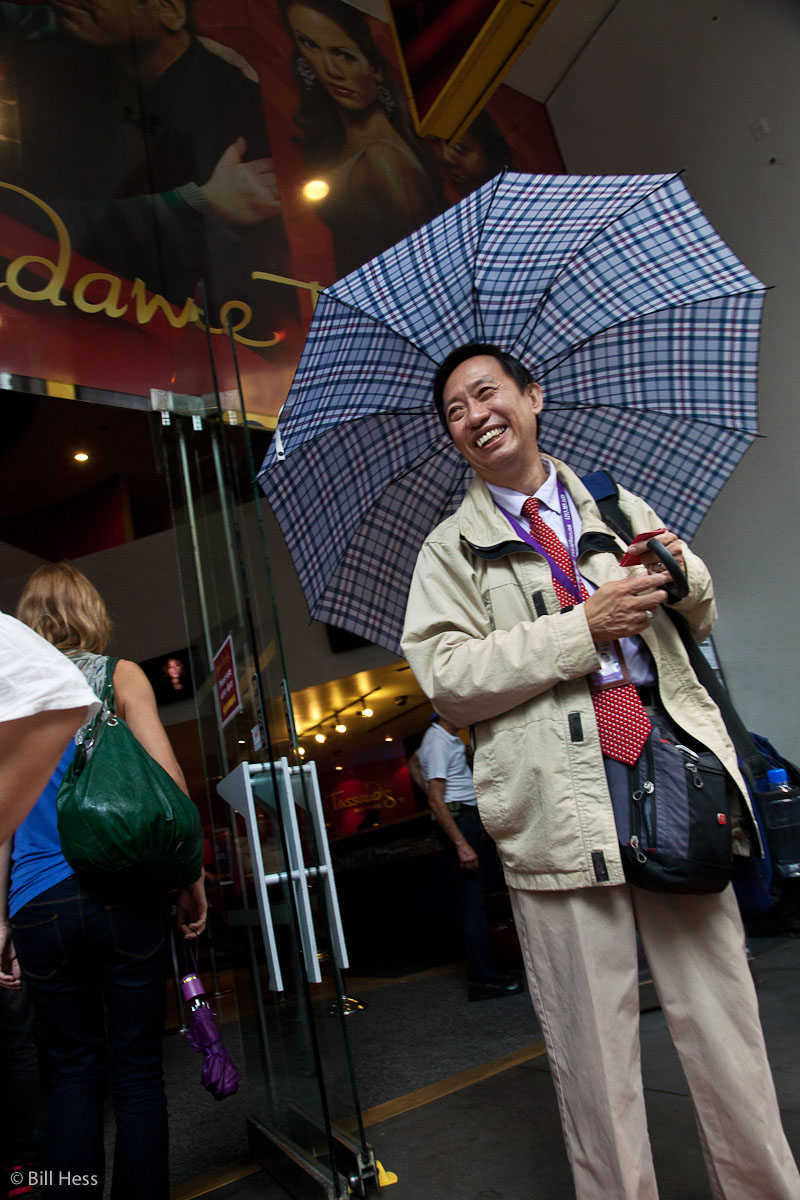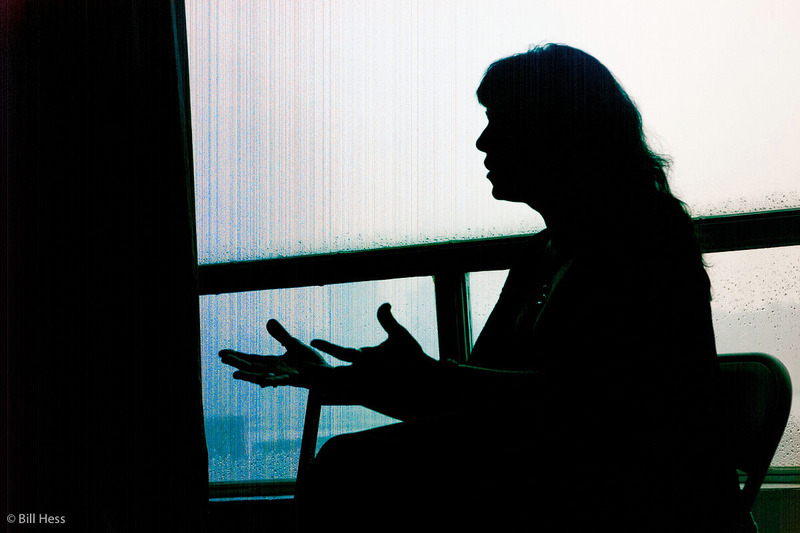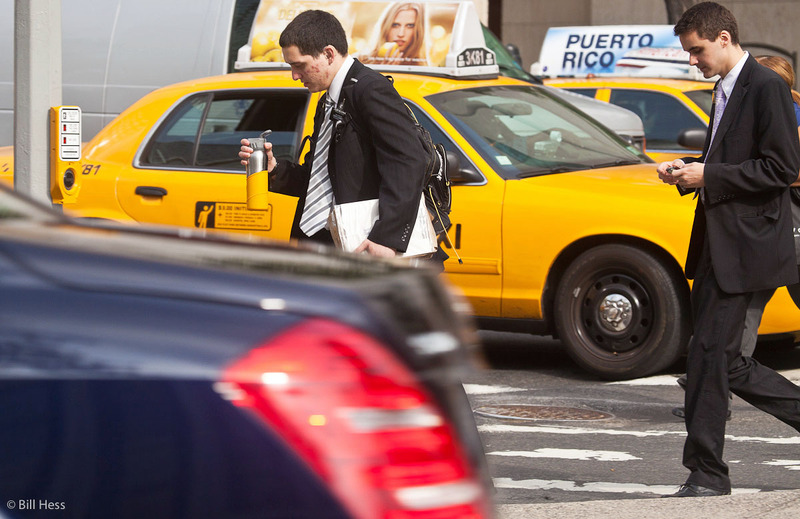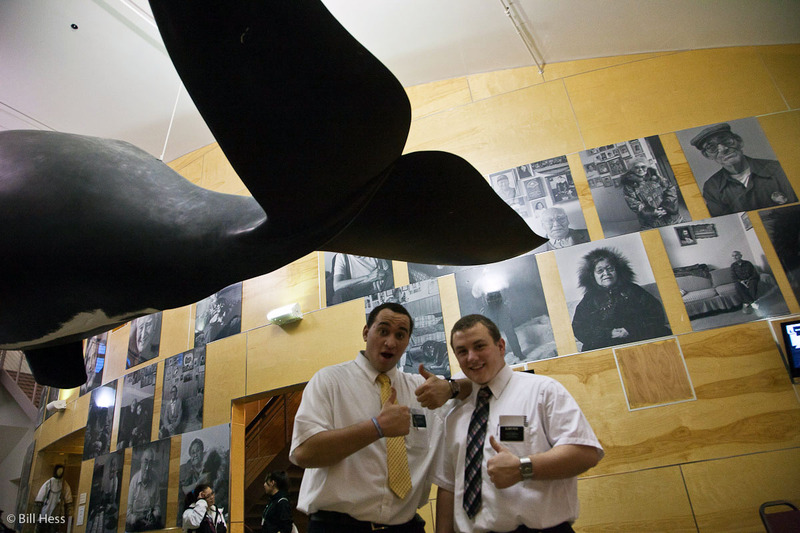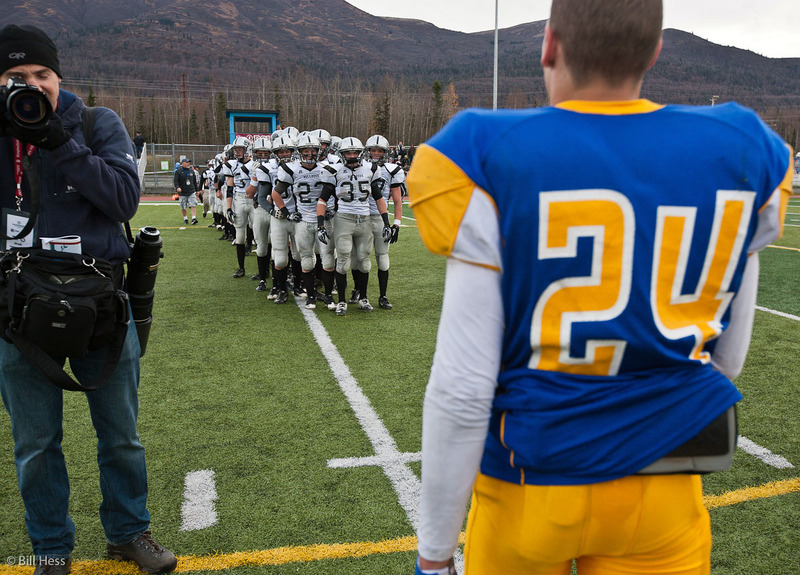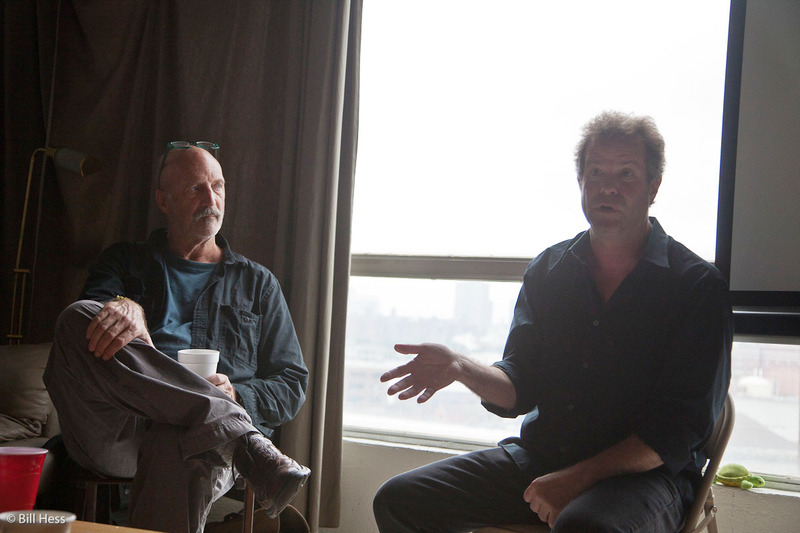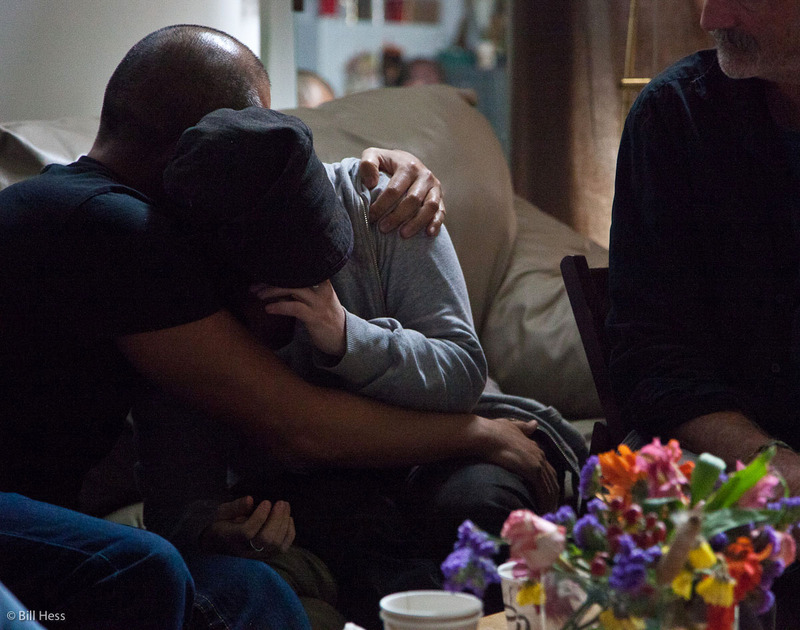
As I noted last night, on the morning of Wednesday, the third shooting day, I had gotten up and left the Brooklyn apartment early to take my laptop to the Apple Store near the Lincoln Center subway stop so that I could get it repaired that day. Then I would have it that night when it came time to edit what I hoped would finally be a successful day's take. For two days in a row, I had failed to make any progress toward shooting the photo essay that I had hoped to shoot on Mormon missionaries at work in New York City.
The workshop session would also start at 9:00, with bagles, fruit and coffee, so I dropped the computer off and then rushed back to Brooklyn by taxi cab, hoping to get there before I missed too much of the critiques or the presentation of the morning guest, Steve Fine, Photo Director for Sports Illustrated.
By the time I entered the loft, the critique sessions had already begun. If I recall correctly, and I'm not certain I do, I walked in during the middle of Andy Kropa's critique. Andy had taken a lighting workshop from David just before the workshop began and now had a screenful of pictures up that he had taken with flash, detached from the camera at the Occupy Wall Street gathering at Zucotti Park the night before.
David was scolding Andy, asking him if he got anything out of the lighting workshop at all, because the first few frames we looked at were poorly lit and a bit weak on composition as well. Then, suddenly, up came a brilliant image of a young protestor with an angry expression on his face, his fist in the air and a skyscraper behind, then another of an angry black preacher, rallying the crowd and another of the crowd itself.
David had given everybody a goal of one good, solid, photo a day and by the time the edit was done, Andy had a good half-dozen strong images on the screen - stronger than any that I had seen in the media. Yes, he had blown the lighting on some inconsequential shots, but, when the shots had mattered, he had nailed the lighting every time.
Tracie Williams was also shooting an essay in Zucotti Park and the day had not seemed to go well for her, although she had a couple of images onscreen that I thought were strong, including one of Susan Sarandon, standing with a look of righteousness upon her face almost eyeball to eyeball with a cop who looked like a human wall, ready to block her progress whatever it took.
It struck me as the classic irresistible force meeting the immovable object.
The photo did not make the cut. Then David zeroed in on a couple of nighttime portraits that Tracie had done. They were strong. David suggested that she try to do more in that mode.
At her lowest point, Tracie could not hide her frustration. Zun Lee wrapped his arms around her and gave her comfort.
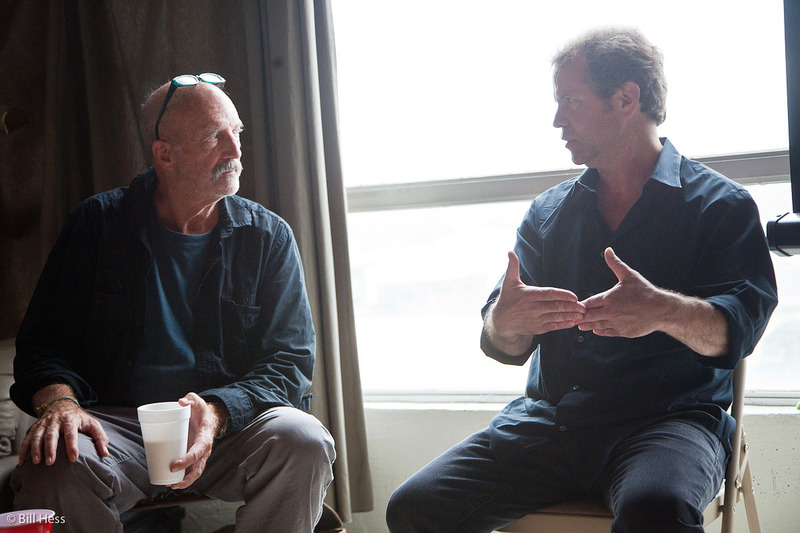
None of the workshop participants had expressed any desire to become sports photographers, but when he introduced Steve Fine, David said that did not matter. Whether one is shooting news, documentary, art, sports or whatever, the goal is to come up with photos that speak and the basic principles that guide Steve Fine in selecting photos for Sports Illustrated are pretty much universal, whatever the discipline or the media outlet.
Fine's primary message to me was that a photographer is his own worst editor. A photographer is too close to his work and gets invested in it. Even as a photographer shoots, she selects pictures in her mind that she thinks are going to be the ones - but maybe they aren't at all. Yet, when the photographer sits down to edit his take, he does not want to yield them.
A photographer often projects strengths and meaning into an image that no one else can see. If a photographer has to explain why he thinks an image is great, then it is not going to work. Fine wants the image to speak to him, not the photographer's words about the picture.
This presents me with a bit of a conundrum. I believe that Steve Fine is right. Yet, except for the spread I shot for National Geographic, I have always been my own editor.
Usually, I have been creating one-man publications that I shoot, edit, report, write, layout, mock up, produce and send to the printers. Always, those publications have been successful with my readers. Yet, there have occassions when I have needed a picture from a take I have done years before and so have dug out the raw take. I have often been surprised to find that I missed my very best image during my original edit.
Still, I have to edit my own take. I have always been and remain a one-man band.
Steve Fine insists that photographers who shoot for him send him their complete, unedited, take. This also shows him how a photographer works. Once he understands this, he is better able to decide how to use the photographer in the future.
He also told us of the great lengths Sports Illustrated goes to plan how to shoot an event, be it the Beijing Olympics or a football game. He and his staff seek to envision every possible angle and moment of action that might happen and to put a photographer with the right equipment in place to shoot these moments.
He showed us the SI Beijing Olympic finals, from grand entry to finale and told us how certain decisions were made. I'm not going to try to sum it all up, but it was impressive, the results spectacular.
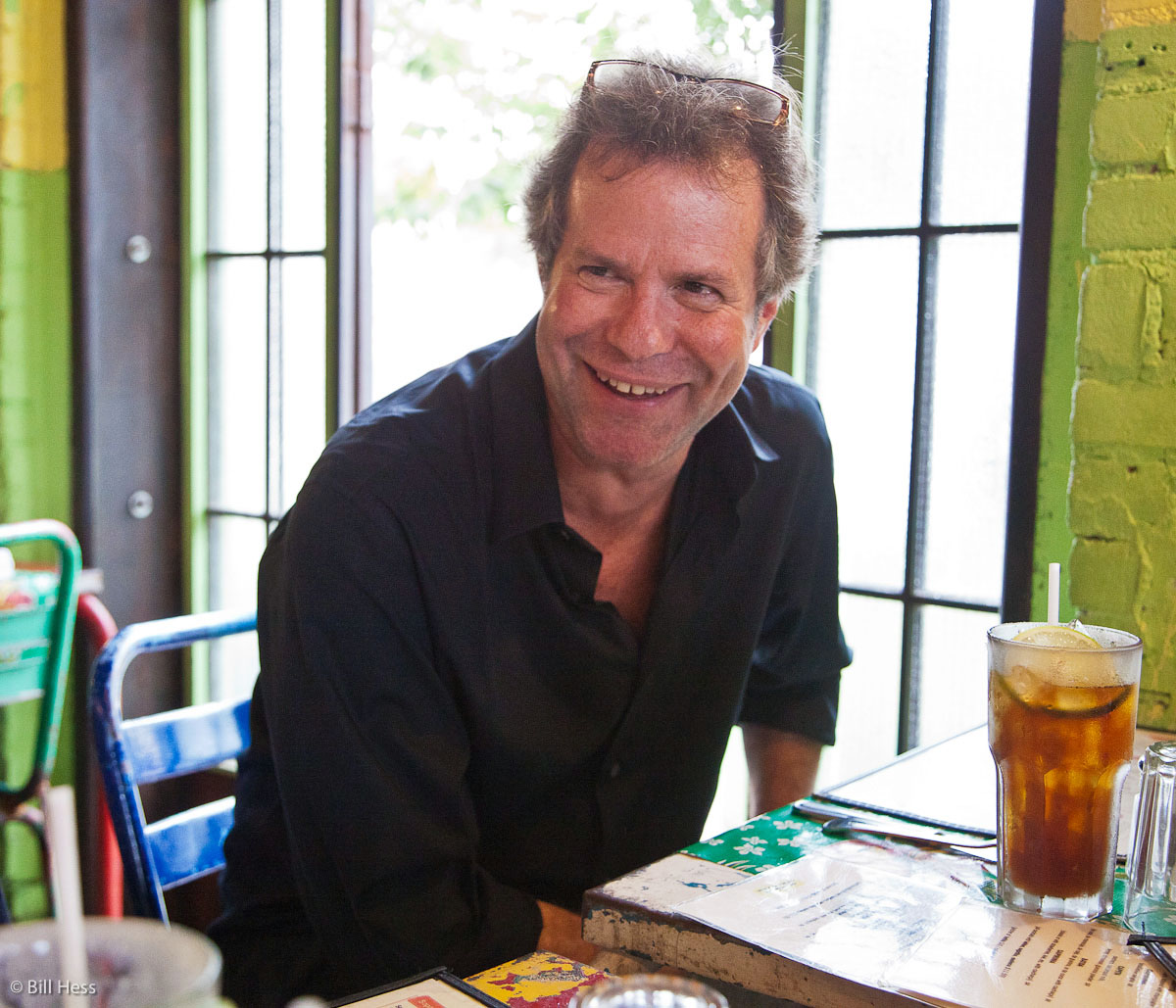
Steve Fine is a busy man and he could have left right after he made his presentation, but he chose instead to stay with us, to participate in the critiques and then to join us for lunch at a nearby Brazilian restaurant.
Mine was one of the presentations he helped to critique. I started off by noting that my hoped-for essay on Mormon missionaries had failed, that I had gotten little more than shots of missionaries leaving the building, plus my shots of Elders Matthews and Bussard riding the subway. Hardly an essay.
He found a couple of the shots reasonably interesting, but noted that many young men in New York wear suits, white shirts and ties and that visually, my pictures could be of any of those young men, Mormons or not. He seemed to think that an essay on missionaries in New York could be a challenge to pull off and asked me what picture or pictures I had specifically hoped to take of missionaries at work.
Whatever they happened to do when I was with them, I told him. I would know the picture when I saw it. He did not think this was the right approach. He advised that I visualize specific pictures and try to figure out how to get them. Furthermore, he chastised me a little bit and said I should have stayed to meet with the mission president.
One must take seriously the advice of one so much more accomplished than himself as Steve Fine is than me. So I gave it some thought. Then I decided that under the circumstance, I had still done the right thing. As to preplaning, of course I imagined certain possible scenarios in my head, such as missionaries getting invited into a home, missionaries getting the door slammed in their face, missionaries talking to passersby on the street, riding bicycles, playing basketball with youth, but the truth was I had no way to know what might happen. The activities of missionaries wandering the street play out in very different and less predictable scenarios than do events taking place on a track, football field, or the racing lanes of a pool.
How could I have known that lady missionaries would board the same train we did? How could I have known that when the crowd thinned out a bit, a very pregnant lady would stand almost between the two young Elders? One cannot plan for these kind of things. One must be ready to react and shoot, whatever happens.
Sometimes, being a photographer is like being a sharp-shooter with a high powered-rifle and scope. Sometimes, it is like being a quick-draw artist with a six-shooter on his hip, drawing and firing as needed. I can sharp-shoot, but must often, I am a quick-draw artist.
As for the mission president, when I found him he had promised to meet with me in 15 minutes and then I had been told to come back in five hours. He had also said that it would "be impossible" for me to shoot pictures of missionaries working in New York, unless I just happened upon them by chance.
Plus, I do understand some basic things about the culture that I grew up in. If I had waited around the temple area for the five hour period to end and had then been fortunate enough to actually be granted a meeting with the president, Elders Matthews and Bussard would have already reached home. All the missionaries would have been gone. It would have been just me and the President, who had already made it clear that the only way I could photograph his missionaries was to happen upon them by chance and even then, there would be parameters he would want me to follow.
I made a judgment call. I believe I made the right one.
It did not result in a photo essay, but as for my long-term, ongoing, Looking Back at Me project, it gave me the material I needed both to deal with the issue of race and to tell the story of how Margie and I came together.
In that sense, I feel I succeeded.
Still, I learned a great deal from Steve Fine and the fact that I disagree with him does not change the fact that I greatly admire what he does at Sports Illustrated.
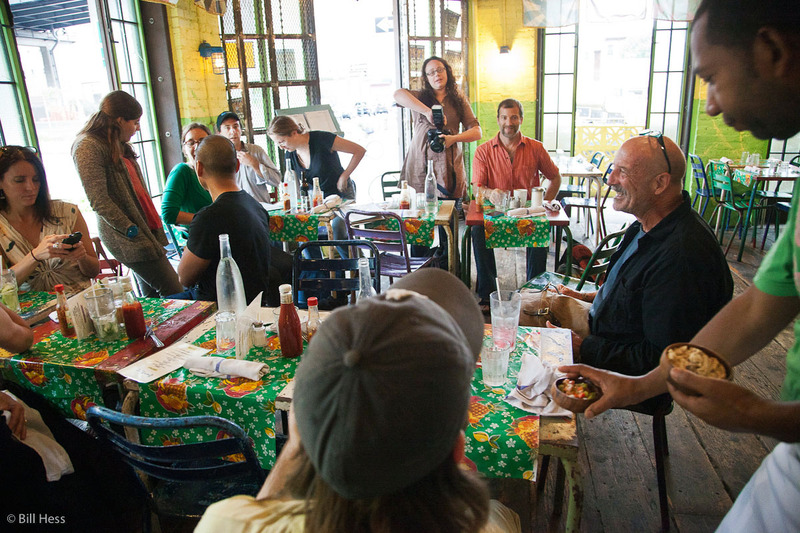
Loft workshop participants at the restaurant. Not everybody was there. A few were off working on their projects.
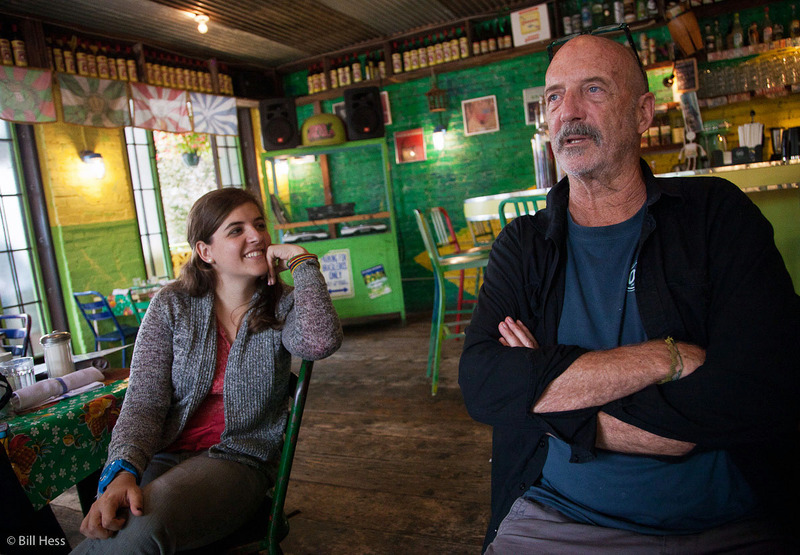
David has an endless reservoir of stories to tell - like when National Geographic sent him to cover the Arctic Slope, he was a passenger in a small plane that was flying through clouds into Anaktuvuk Pass. The pilot goofed. His landing gear struck the ridge of the mountain, was torn off the plane, which then had to make a belly landing.
Workshopper Isabella Eseverri of Venezuela listens as the master speaks.
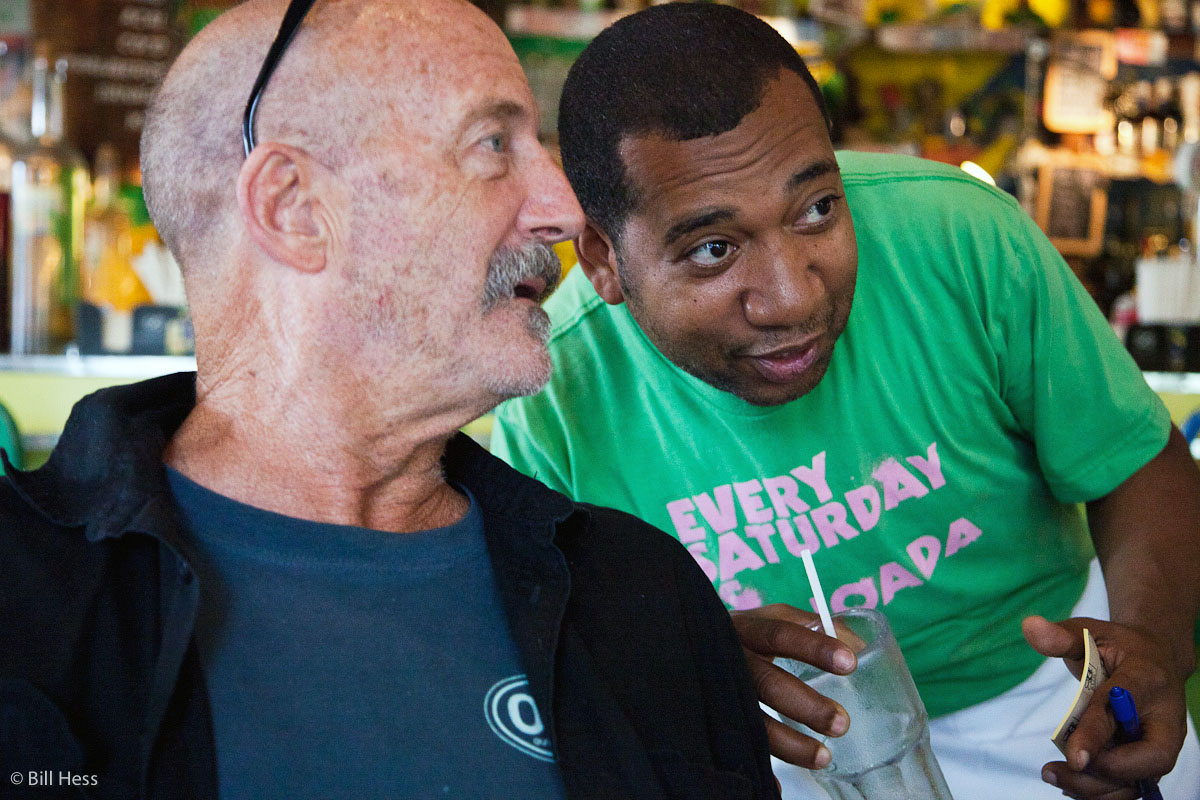
David and our waiter exchanged a few sentences in Portugese - rather risqué sentences, it turned out. David would soon return to Rio De Janeiro to finish up his Rio Book - a personal project dealing with one night through work spread out over years.
He also has a Rio spread in the works for National Geographic.
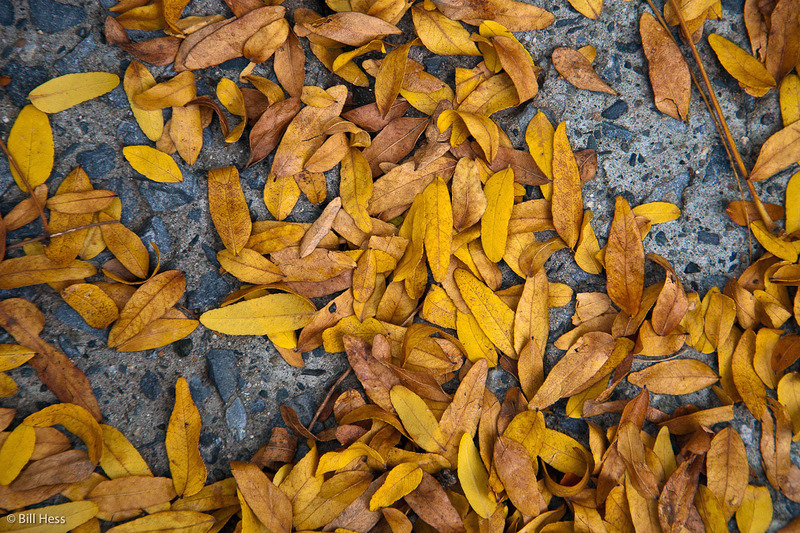
After lunch, we all walked off in our own directions. The leaves on the trees in New York were still green for the most part, but at least one tree species had turned early and had already dropped yellow leaves on the sidewalk.
I now had to find a new subject to shoot for my essay. Andy Kropa suggested that I might think about shooting an essay on street and subway preachers, which New York has in abundance. Perhaps I could even work one of my Mormon missionary pictures into it. I liked the suggestion. I decided to do it.
David gives every workshop participant an hour or two of private time and mine was scheduled for 4:00 PM, which did not leave me much time to go anywhere. I decided to just wander about the local area to see if I might find any street preachers there. I didn't.
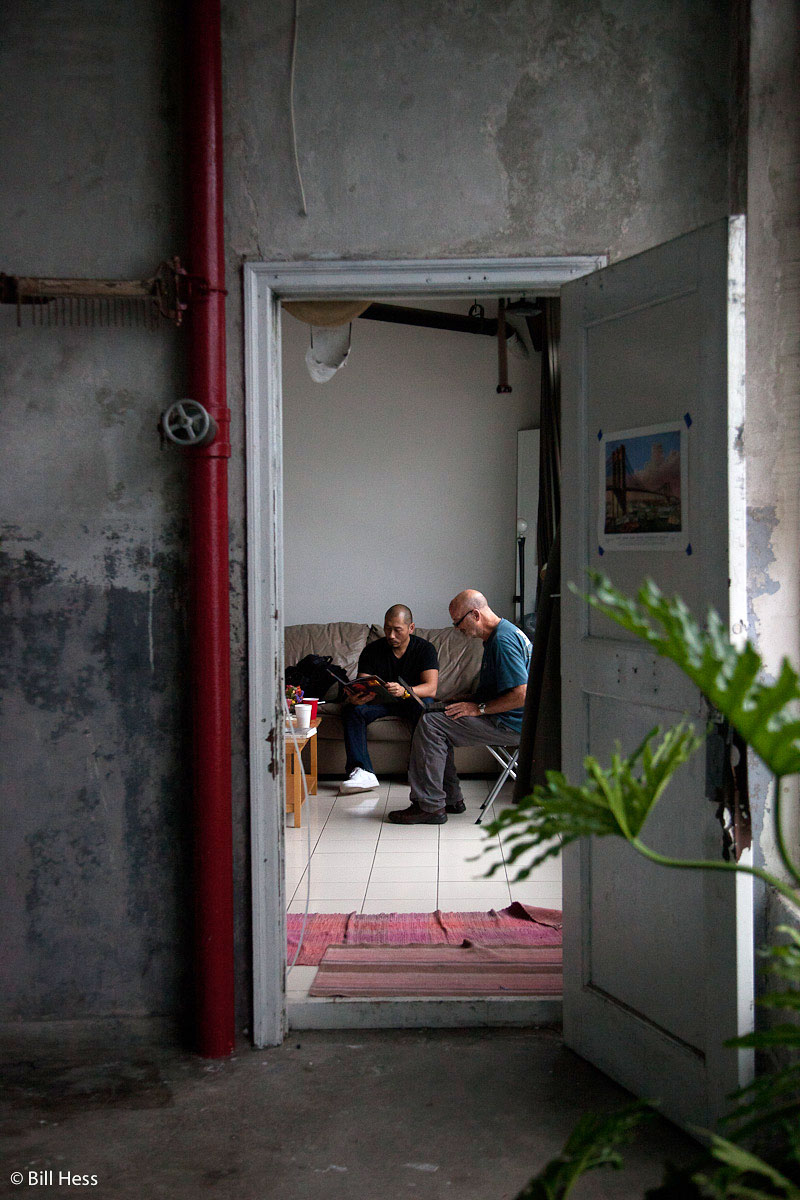 I did find Zun Lee, wandering about on the sidewalks Brooklyn's Williamsburg neighborhood just like I was. Zun was scheduled to see David just ahead of me. We went into a coffee shop and he bought me an Americano. In my earlier posts, I mentioned that Zun had only recently discovered that his father was black. As his father had not been there for him, and that is the stereotype that many have of black fathers, Zun had been wanting to his essay on black fathers who are there for their children.
I did find Zun Lee, wandering about on the sidewalks Brooklyn's Williamsburg neighborhood just like I was. Zun was scheduled to see David just ahead of me. We went into a coffee shop and he bought me an Americano. In my earlier posts, I mentioned that Zun had only recently discovered that his father was black. As his father had not been there for him, and that is the stereotype that many have of black fathers, Zun had been wanting to his essay on black fathers who are there for their children.
It seemed that it might be too risky - a topic that he might fail to accomplish in just five shooting days - actually, a little more than four, if one takes everything into consideration. Zun came to the workshop believing that maybe he would take on a safer subject, something more easily accomplished.
Then, when he saw the slides of my father that I had shown on the opening day, he told me, he had been moved. In them, he said, he found the inspiration and courage to shoot the essay of his heart. He had already come up with some powerful, powerful, images.
We parted. He went to his meeting and I continued to wander fruitlessly. When I came for my session with David, he was still meeting with Zun. David describes his role in these one-on-ones as both teacher and confessor - kind of like a Catholic Priest. Anything goes there, nothing off bounds.
When I met with him, it would have been hard to confess anything, as people who wanted him for one thing or another kept coming in and out. That was okay with me. I didn't confess anything, but I did talk about some of my projects that few know about. I suspect that if I finish all the work that I want to do I will, in the process, confess everything to the world anyway. He said he would help.
Sometimes, I feel bad for the families of writers and photographers. We are driven to do this, to take those aspects of our lives that so many others hold private and quiet and then to put them before the world in our work, one way or another.
I have barely begun, but the day is coming.
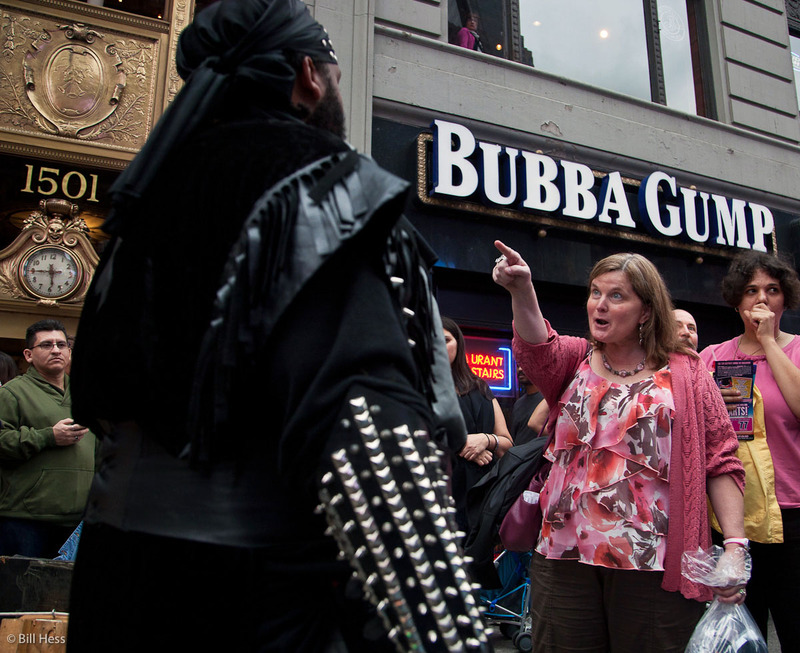
After I met with David, I set out to see if I could find some street preachers. The previous Saturday, just before the workshop began, I had gone to Times Square to get my ceremonial pretzel and there had found this preacher and his fellow preachers, being scolded harshly, shrilly, loudly and pointedly by this lady.
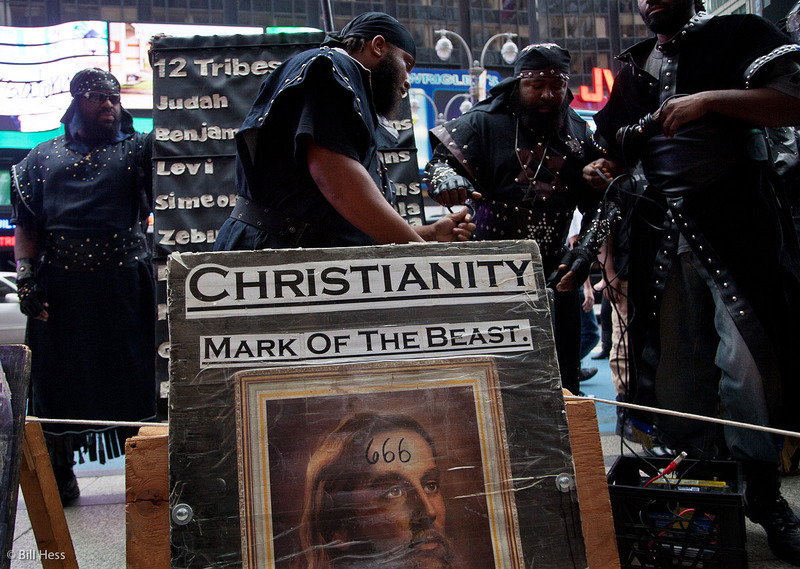
This is why she scolded them so severely, because of the numbers they had written on the picture over the forehead of Jesus. The mark of beast, the sign of Satan, written upon the forehead of He whom she regards as Savior. She came at the little band of street preachers so strongly that they packed up and moved.
I don't think their beef was against Jesus, but just how he is portrayed. I heard one of them tell the lady that Jesus is black and should be portrayed as black.
I spent only a few minutes in their presence and did not really figure out what they are about or what message they were trying to preach. I asked one, and he said they had to go, they would set up somewhere else and then if I came by, he would tell me.
But I was not shooting an essay then, I did not want to stay on Times Square and so I did not follow when they wandered off. Two white police officers had carefully observed the exchange between the street preachers and the woman, ready to take action if necessary. They seemed to be well-trained on the need to respect people's civil right to self-expression and so did nothing but observe.
As the street preachers walked away, I asked the police officers who they were.
"Just a few assholes, trying to get attention," one of them answered.
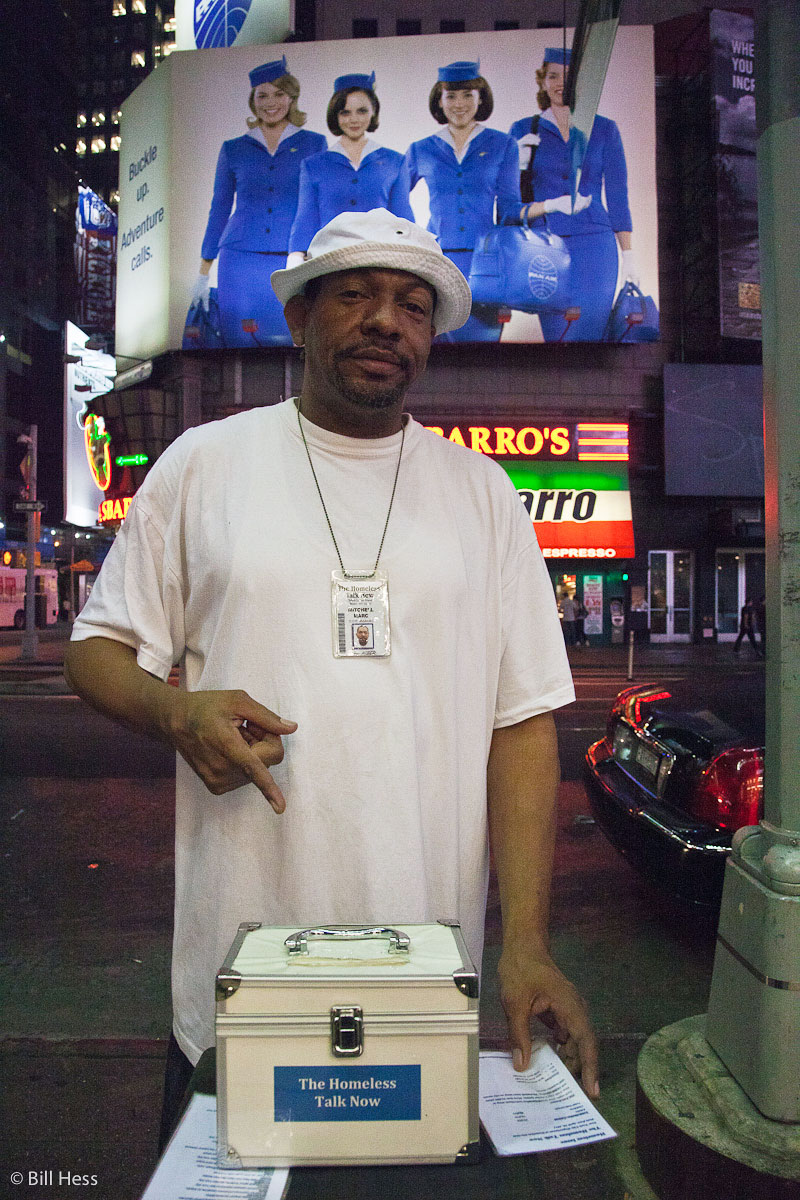 Now, as my so far totally unproductive third shooting day turned into night, I remembered the street preachers. I also remembered seeing a woman preaching on a Times Square sidewalk as I ate my ceremonial pretzel, and it seemed like I had seen at least one more preacher on Times Square the previous Saturday as well. So I took the subway to Times Square, certain that I would find street preachers there.
Now, as my so far totally unproductive third shooting day turned into night, I remembered the street preachers. I also remembered seeing a woman preaching on a Times Square sidewalk as I ate my ceremonial pretzel, and it seemed like I had seen at least one more preacher on Times Square the previous Saturday as well. So I took the subway to Times Square, certain that I would find street preachers there.
I didn't - not a single one. I saw this guy and his partner, collecting money for the homeless. I thought they might they were preachers. They weren't - they were just people doing the holy work that all great faiths advocate - to house and feed the poor.
So I took a picture, gave them $5.00 and moved on.
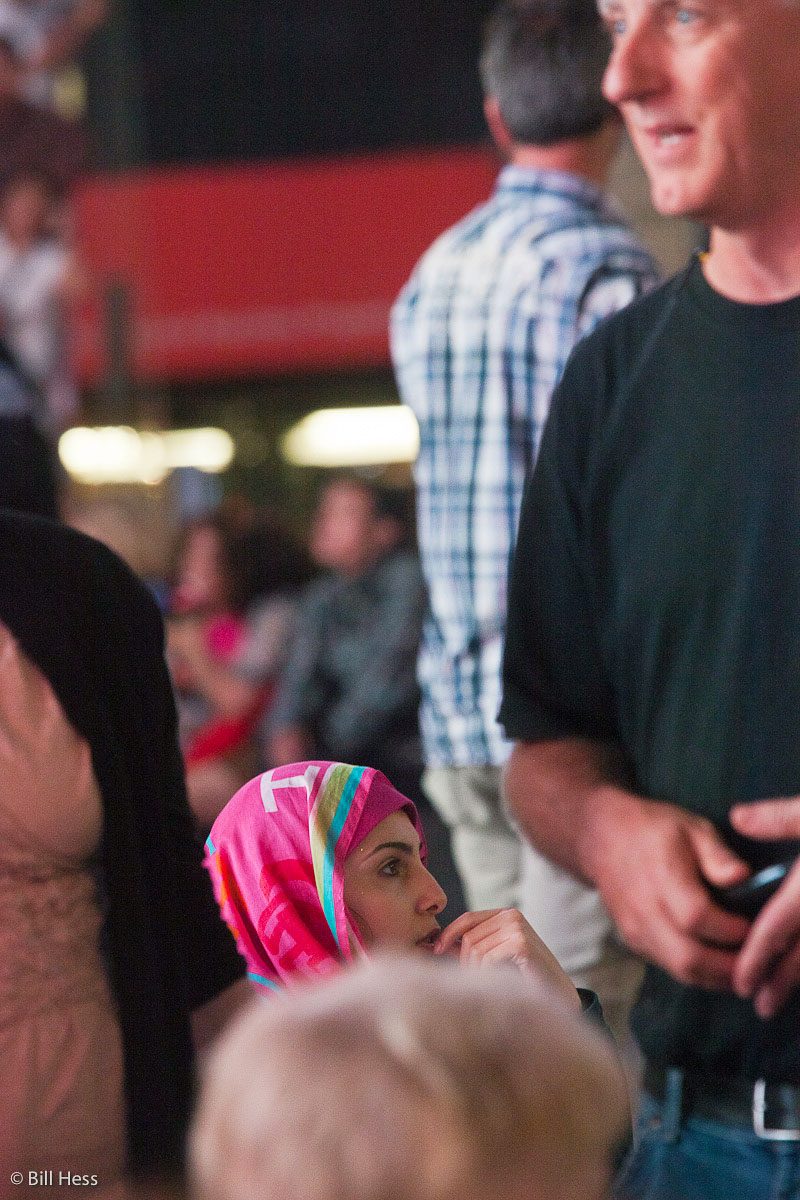
I saw this Muslim woman, with her family, in the crowd. I took a couple of wide angle shots of them eating at a table, then pulled back and shot this telephoto view... but... she wasn't preaching.
True, her attire carried a message of faith, but she was not trying to convert anybody. She was just trying to enjoy an evening in the best known landmark in the greatest city on earth with her family.
In past trips to New York, I had seen preachers working the subway. Surely, if I searched, I would find preachers down in the subterranean depths of New York City.
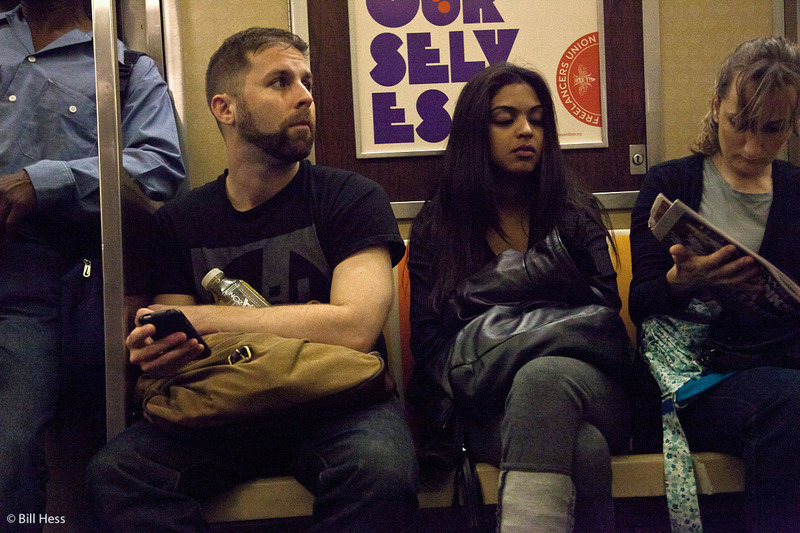
First,I had to go back to the Apple Store and pick up my laptop. I needed to get there by 9:00 PM - closing time. So I jumped on a train and off I went. As the train rolled down the track, I began to envision different pictures I might take of preachers, working the bowels of the subway system.
I became quite taken by some of these envisioned but as yet unphotographed images. Suddenly, I realized that I had passed the Lincoln Center station at 66th street. It was getting close to 9:00, but no big deal. There was still time to hop off at the next station, catch a train back and pick up my computer.
The train reached the next station and just kept going - and then the next, the next after that, and still the next... until finally we stopped somewhere in the 170's. It was the late-night express.
I got out, caught a train back, exited at Lincoln Center, literally ran up the stairs, out onto the road and dashed off toward the Apple Store. I reached the door at 9:03. It was locked. No one would unlock it.
I would have no computer tonight. I would have to take the time to return to the Apple Store and get it the next day. Well, I figured, I would do a Central Park preacher search - at least that way I would be close.
I spent the next few hours roaming about the subway, especially the larger stations at Columbus Circle and below Times Square. I did not encounter a preacher of any kind. Not one.
Three shooting days had now passed. I did not have a single image done on my essay. There was only one full shooting day left - Thursday. Perhaps I could get in a few hours Friday, but that seemed kind of unlikely.
Humiliation - is that where I was headed? I was not willing to accept such an idea.
It kind of looked like it, though.
 Friday, January 20, 2012 at 1:31AM
Friday, January 20, 2012 at 1:31AM 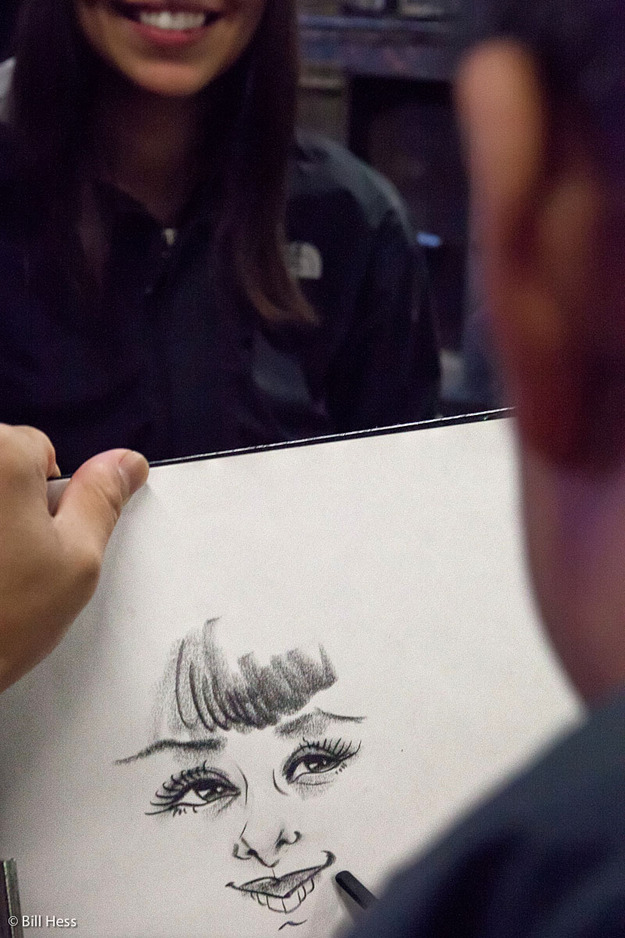 In the end, for reasons that I will explain later, I would have one hour to edit my Times Square take and pull the selects together to take to the final critique that would determine what the final images for the evening slide show would be.
In the end, for reasons that I will explain later, I would have one hour to edit my Times Square take and pull the selects together to take to the final critique that would determine what the final images for the evening slide show would be.

